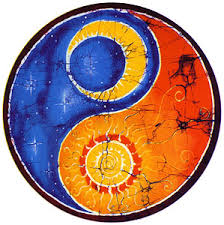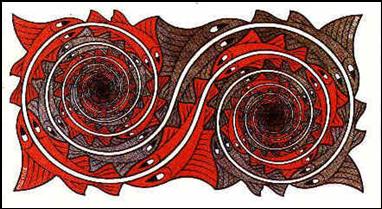
Henry Kono Sensei regularly opens his seminars by saying that he asked Morihei Ueshiba what the difference between his own Aikido and that of his students. What was the essential quality that made his work so different? Ueshiba Sensei responded that his own Aikido was different because he understood the principle of Yin and Yang.

Yin Yang is a philosophical concept. It is not the pretty little black and white swirly picture. The principle of yin yang is often pictorially represented by the Taijitu (literally "diagram of the supreme ultimate"). This is the divided circle image we are all so familiar with.

The philosophical principle is used to describe how polar opposites and contrary forces are interconnected and interdependent. The power of each crests so they give rise to each other in turn. It in the Taoist tradition a study of the "grand and ultimate" a study of everything really.
from wikipedia
"In Taoist philosophy, yin and yang arise together from an initial quiescence or emptiness (wuji, sometimes symbolized by an empty circle), and continue moving in tandem until quiescence is reached again. For instance, dropping a stone in a calm pool of water will simultaneously raise waves and lower troughs between them, and this alternation of high and low points in the water will radiate outward until the movement dissipates and the pool is calm once more. Yin–yang, thus, are always opposite and equal qualities. Further, whenever one quality reaches its peak it will naturally begin to transform into the opposite quality: grain that reaches its full height in summer (fully yang) will produce seeds and die back in winter (fully yin) in an endless cycle."
So the question remains, how does this seemingly esoteric principle affect and shape the practice of Aikido? The answer is simple, it is everything in our practice and lives. We are expressions of the myriad of binary pairs that form a whole. Since it is very difficult to talk about yin with summoning forth it's balancing power of yang, I will give a short,simple and somewhat superficial list so maybe the student of the path can grow to see the principle for themselves in all aspects of practice.
Peace/War
teacher/student
success/failure
self/others
push/pull
force/gentle
control/follow
soft/hard
circle/line
attack/defend
internal/external
in/out
up/down
freedom/restraint
efficient/clumsy
pain/comfort
rest/exertion
strict/permissive
balance/kuzushi

Any study of one aspect demands examination of the relationship it holds with its opposite. Obsession with an single aspect without a deep study of the opposite idea takes the student away from understanding of what Aiki truly is. It is the balance of the forces.
Where does the Aikidoka fit into this relationship? I can give you a hint, a skillful Aikidoka lays at the center as the catalyst of the blending energies. Aikido is the surfing the crest as one form transforms into the next. Appropriate use of each of the binary energies to create a whole.
In the mystic circles every once in a while you will find an individual that has entered the state of mind where all is one! This is a great and important state to understand. However, Lowry Sensei told me that people in his lineage that remain there too long are considered to have the 'stink of Zen'. You see yin yang can only be understood when you get beyond the polarities, when you transcend dualistic and binary thought models. The kicker is that the expression of yin yang is 2, and it is 1! All expression of energy falls into 2 and 1 at the same time!
"The only way to replace what you have now requires a belief in yin and yang principle so strongly that it will over-ride any argument your mind will throw at you."
- Henry Kono Sensei








his speech was good, his touch and that of his students was disappointing.
ReplyDeleteI understand what you are talking about anonymous. I have a buddy and I travel to his dojo. He has good ideas about training but the touch of his students don't match his words.
ReplyDeleteWeird right?
Enjoyable exploration of the yin yang concept. Interesting imagery as well!
ReplyDelete